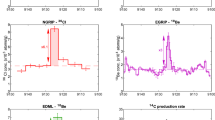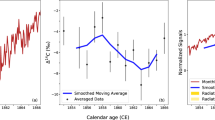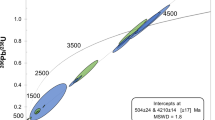Abstract
MEASUREMENT of radionuclides by nuclear accelerator spec-trometry may lead to wider application of measurement of long-lived cosmogenic isotopes to archeological, geophysical and astrophysical problems (see ref. 1 for further details of the technique). We previously2 discussed the prospects for the isotope 10Be and reported the successful measurement of this isotope using both the internal2 and the external3 ion sources of the Grenoble cyclotron. 10Be (half life = 1.5 × 106yr; ref. 4) is formed by the interaction of cosmic rays with the Earth's atmosphere, and then precipitated out into various geophysical reservoirs such as marine sediments and polar ice5. The 10Be profile in these reservoirs can thus be used to search for evidence of historical variations in parameters (geomagnetic field, solar modulation, primary cosmic ray intensity) which influence the deposition rate. We report here the use of the accelerator technique for the determination of 10Be concentrations in samples of Antarctic ice believed to be about 1, 000 and 5, 000 yr old. The only published measurement for 10Be in polar deposits is that of McCorkell et al.6 who made their measurement on a sample extracted from 1.2 × 106 l of Greenland ice. The present measurements were made on samples from 10 l. We believe this difference is indicative of the tremendous potential that is offered by the accelerator technique.
This is a preview of subscription content, access via your institution
Access options
Subscribe to this journal
Receive 51 print issues and online access
$199.00 per year
only $3.90 per issue
Buy this article
- Purchase on Springer Link
- Instant access to full article PDF
Prices may be subject to local taxes which are calculated during checkout
Similar content being viewed by others
References
Gove, H. E. (ed.), Proc. 1st Conf. Radiocarbon Dating with Accelerators (University of Rochester, 1978).
Raisbeck, G. M., Yiou, F., Fruneau, M. & Loiseaux, J. M. Science (in the press).
Raisbeck, G. M., Yiou, F., Fruneau, M., Lieuvin, M. & Loiseaux, J. M. Proc 1st Conf. Dating with Accelerators, 38–46 (1978).
Yiou, F. & Raisbeck, G. M. Phys. Rev. Lett. 29, 372–375 (1972).
Lal, D. & Peters, B. in Hanbuch der Physik Vol. 46/2, (ed. Sitte, K.) 551–612 (Springer,Berlin, 1967).
McCorkell, R., Fireman, E. L. & Langway, C. C., Jr Science 158, 1690–1692 (1967).
Lorius, C. & Donnou, D. Courrier CNRS October (1978).
Aitken, M. J. Phys. Rep. 40 C, 277–351 (1978).
Somayajulu, B. L. K. Geochim. cosmochim. Acta 41, 909–913 (1977).
Tanaka, S., Inoue, T. & Imamura, M. Earth planet. Sci. Lett. 37, 55–60 (1977).
Inoue, T. & Tanaka, S. (preprint, 1978).
Finkel, R., Krishnaswami, S. & Clark, D. L. Earth planet. Sci. Lett. 35, 199–204 (1977).
Pierce, J. W. & Clark, M. J. Nature 273, 456–458 (1978).
Author information
Authors and Affiliations
Rights and permissions
About this article
Cite this article
RAISBECK, G., YIOU, F., FRUNEAU, M. et al. Measurement of 10Be in 1,000- and 5,000-year-old Antarctic ice. Nature 275, 731–733 (1978). https://doi.org/10.1038/275731a0
Received:
Accepted:
Issue Date:
DOI: https://doi.org/10.1038/275731a0
This article is cited by
-
Cosmogenic 10Be concentrations in Antarctic ice during the past 30,000 years
Nature (1981)
-
Ice core studies: dating the past to find the future
Nature (1981)
-
Bibliography section
Journal of Radioanalytical Chemistry (1980)
-
Deposition rate and seasonal variations in precipitation of cosmogenic 10Be
Nature (1979)
-
Radioisotope clocks in archaeology
Nature (1979)
Comments
By submitting a comment you agree to abide by our Terms and Community Guidelines. If you find something abusive or that does not comply with our terms or guidelines please flag it as inappropriate.



